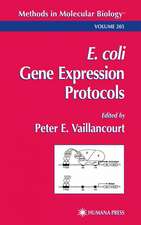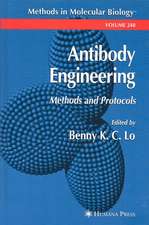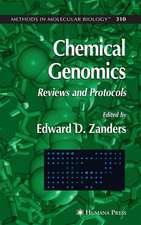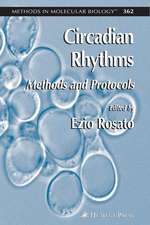Membrane Protein Protocols: Expression, Purification, and Characterization: Methods in Molecular Biology, cartea 228
Editat de Barry S. Selinskyen Limba Engleză Hardback – 29 mai 2003
| Toate formatele și edițiile | Preț | Express |
|---|---|---|
| Paperback (1) | 911.05 lei 43-57 zile | |
| Humana Press Inc. – 10 noi 2010 | 911.05 lei 43-57 zile | |
| Hardback (1) | 916.80 lei 43-57 zile | |
| Humana Press Inc. – 29 mai 2003 | 916.80 lei 43-57 zile |
Din seria Methods in Molecular Biology
- 9%
 Preț: 856.72 lei
Preț: 856.72 lei - 18%
 Preț: 1337.94 lei
Preț: 1337.94 lei - 18%
 Preț: 1342.80 lei
Preț: 1342.80 lei - 18%
 Preț: 899.81 lei
Preț: 899.81 lei - 18%
 Preț: 1175.41 lei
Preț: 1175.41 lei - 18%
 Preț: 1332.17 lei
Preț: 1332.17 lei - 18%
 Preț: 1336.97 lei
Preț: 1336.97 lei - 18%
 Preț: 1181.73 lei
Preț: 1181.73 lei - 18%
 Preț: 1338.68 lei
Preț: 1338.68 lei - 20%
 Preț: 637.64 lei
Preț: 637.64 lei - 23%
 Preț: 632.22 lei
Preț: 632.22 lei - 5%
 Preț: 868.72 lei
Preț: 868.72 lei - 5%
 Preț: 696.72 lei
Preț: 696.72 lei - 5%
 Preț: 701.45 lei
Preț: 701.45 lei - 5%
 Preț: 703.21 lei
Preț: 703.21 lei - 5%
 Preț: 712.68 lei
Preț: 712.68 lei - 5%
 Preț: 718.30 lei
Preț: 718.30 lei - 15%
 Preț: 637.84 lei
Preț: 637.84 lei - 18%
 Preț: 985.49 lei
Preț: 985.49 lei - 5%
 Preț: 706.20 lei
Preț: 706.20 lei - 18%
 Preț: 878.72 lei
Preț: 878.72 lei - 15%
 Preț: 638.96 lei
Preț: 638.96 lei - 15%
 Preț: 628.86 lei
Preț: 628.86 lei - 18%
 Preț: 1359.61 lei
Preț: 1359.61 lei - 5%
 Preț: 713.92 lei
Preț: 713.92 lei - 18%
 Preț: 886.62 lei
Preț: 886.62 lei - 18%
 Preț: 934.55 lei
Preț: 934.55 lei - 15%
 Preț: 635.00 lei
Preț: 635.00 lei - 5%
 Preț: 709.90 lei
Preț: 709.90 lei - 18%
 Preț: 946.69 lei
Preț: 946.69 lei - 5%
 Preț: 704.97 lei
Preț: 704.97 lei -
 Preț: 180.11 lei
Preț: 180.11 lei - 5%
 Preț: 717.45 lei
Preț: 717.45 lei - 18%
 Preț: 925.28 lei
Preț: 925.28 lei - 5%
 Preț: 996.10 lei
Preț: 996.10 lei - 15%
 Preț: 627.45 lei
Preț: 627.45 lei - 5%
 Preț: 1014.54 lei
Preț: 1014.54 lei - 18%
 Preț: 951.84 lei
Preț: 951.84 lei - 5%
 Preț: 1002.92 lei
Preț: 1002.92 lei - 5%
 Preț: 1102.03 lei
Preț: 1102.03 lei - 5%
 Preț: 567.22 lei
Preț: 567.22 lei - 18%
 Preț: 2039.44 lei
Preț: 2039.44 lei - 5%
 Preț: 1248.71 lei
Preț: 1248.71 lei - 15%
 Preț: 623.52 lei
Preț: 623.52 lei - 18%
 Preț: 1336.11 lei
Preț: 1336.11 lei - 18%
 Preț: 1341.26 lei
Preț: 1341.26 lei - 18%
 Preț: 1085.72 lei
Preț: 1085.72 lei - 18%
 Preț: 1353.39 lei
Preț: 1353.39 lei - 18%
 Preț: 1081.17 lei
Preț: 1081.17 lei
Preț: 916.80 lei
Preț vechi: 1118.05 lei
-18% Nou
Puncte Express: 1375
Preț estimativ în valută:
162.26€ • 190.28$ • 142.26£
162.26€ • 190.28$ • 142.26£
Carte tipărită la comandă
Livrare economică 26 ianuarie-09 februarie 26
Preluare comenzi: 021 569.72.76
Specificații
ISBN-13: 9781588291240
ISBN-10: 1588291243
Pagini: 334
Ilustrații: XXII, 334 p.
Dimensiuni: 152 x 229 x 24 mm
Greutate: 0.69 kg
Ediția:2003
Editura: Humana Press Inc.
Colecția Humana
Seria Methods in Molecular Biology
Locul publicării:Totowa, NJ, United States
ISBN-10: 1588291243
Pagini: 334
Ilustrații: XXII, 334 p.
Dimensiuni: 152 x 229 x 24 mm
Greutate: 0.69 kg
Ediția:2003
Editura: Humana Press Inc.
Colecția Humana
Seria Methods in Molecular Biology
Locul publicării:Totowa, NJ, United States
Public țintă
ResearchCuprins
Expression of Membrane Proteins.- Expression and Purification of the Amphipathic Form of Rabbit Cytochrome b5 in Escherichia coli.- Dihydroorotate Dehydrogenase of Escherichia coli.- A General Approach for Heterologous Membrane Protein Expression in Escherichia coli.- Expression of Membrane-Bound Iron-Sulfur Proteins.- Heterologous Expression of Human Scavenger Receptor Class B Type I (SR-BI) in Pichia pastoris.- Expression of Oligomeric Amiloride-Sensitive Epithelial Sodium Channel in Sf9 Insect Cells.- Functional Expression of His-Tagged Rhodopsin in Sf9 Insect Cells.- Detergent Selection in Membrane Protein Purification.- Preparation of Glycerol Facilitator for Protein Structure and Folding Studies in Solution.- Solubilization of Chemokine Receptors from Cell Membranes.- A Systematic Approach for the Solubilization of the Integral Membrane Protein Lysophospholipid.- Membrane Protein Purification.- Purification of Omp50, a Minor Porin of Campylobacter jejuni.- Purification of Porins from Mycobacterium smegmatis.- Isolation of the Melanocortin 5 Receptor.- Purification of Mammalian Serine Palmitoyltransferase, a Hetero-Subunit Enzyme for Sphingolipid Biosynthesis, by Affinity-Peptide Chromatography.- Purification of Phosphatidylglycerophosphate Synthase from Cultured Mammalian Cells.- Purification of Pancreastatin Receptor from Rat Liver Membranes.- Purification, Reconstitution, and Functional Characterization of Zinc Transporter from Rat Renal Brush Border Membranes.- Isolation of Lipid Raft-Associated Proteolipids.- Purification of Membrane-Bound Catechol-O-Methyltransferase.- Purification and Characterization of Transporter Proteins from Human Erythrocyte Membrane.- Purification of the Human Erythrocyte PS-Stimulated Mg2+-ATPase.- Reconstitution and Assay of Biogenic Membrane-Derived Phospholipid Flippase Activity in Proteoliposomes.- Expression, Purification, and Reconstitution of Rat Liver Carnitine Palmitoyltransferase I.- Structural Analysis of Membrane Proteins.- Crystallization in Lipidic Cubic Phases.- Optical Biosensor Assay Using Retroviral Receptor Pseudotypes.
Recenzii
"Investigators working with membrane proteins will want to acquire this book. This is a useful compilation of protocols. . .there is much of utility in this book"-Doody's Health Sciences Book Review Journal
"...a useful reference work for researchers investigating the structure and function of membrane proteins." -- Immunology News
"...provides good food for thought for new and advanced membrane protein researchers." - ChemBioChem
"...highly recommendable to people working in proteomics..." - Proteomics Journal
"...a useful reference work for researchers investigating the structure and function of membrane proteins." -- Immunology News
"...provides good food for thought for new and advanced membrane protein researchers." - ChemBioChem
"...highly recommendable to people working in proteomics..." - Proteomics Journal
Textul de pe ultima copertă
Recent developments in molecular biology and biochemistry have made it possible to determine the three-dimensional structure of membrane proteins and so come to a full understanding of their function. In Membrane Protein Protocols: Expression, Purification, and Characterization, researchers at major universities and research centers around the world describe in detail the key techniques that have proven successful in the study of receptors and transport proteins. The book provides examples of how different membrane proteins can be overexpressed in both prokaryotic and eukaryotic expression systems, how natural and overexpressed proteins can be solubilized from their host membranes, and how the solubilized protein can be purified in active form. Each protocol contains step-by-step instructions to ensure success, troubleshooting advice, lists of reagents, and tips on avoiding pitfalls.
Timely and highly practical, Membrane Protein Protocols: Expression, Purification, and Characterization offers investigators proven methods to determine the three-dimensional structure of membrane receptors and transport proteins, as well as proven practical help in the discovery of new clinical targets for the design of novel pharmaceutical agents useful in treating cancer, bacterial and viral infection, and many metabolic diseases.
Timely and highly practical, Membrane Protein Protocols: Expression, Purification, and Characterization offers investigators proven methods to determine the three-dimensional structure of membrane receptors and transport proteins, as well as proven practical help in the discovery of new clinical targets for the design of novel pharmaceutical agents useful in treating cancer, bacterial and viral infection, and many metabolic diseases.
Caracteristici
Includes supplementary material: sn.pub/extras
















